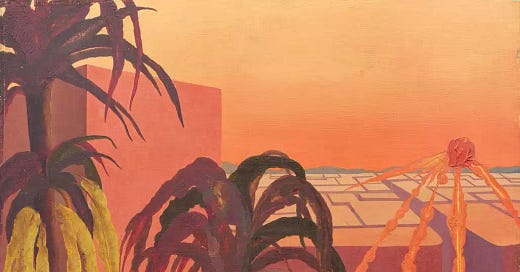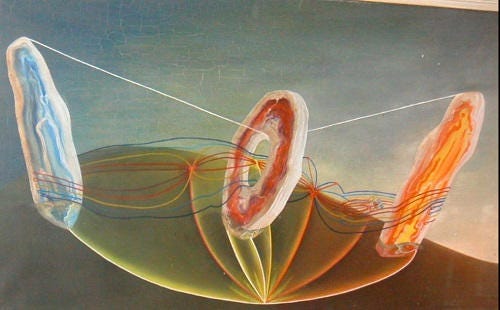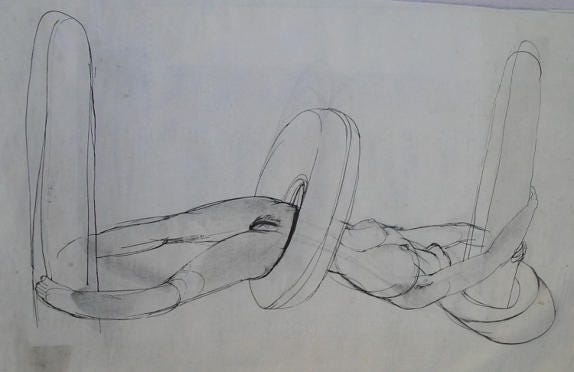Today is the summer solstice and the birthday of Surrealist angel Nusch Éluard. It’s a muggy weekend in the UK after a hot, sunny week. Once again, I am thinking about the Surrealist Summer series I touched on last year, while the Ithell Colquhoun retrospective has just opened at Tate Britain. She’s been on my mind lately, so I wanted to talk briefly about a couple of her works.
Roman Sun (1947) is tropical and hot, bursting with energy. The palm trees almost function as a spiritual aerial in this maze of urban habitation, with its indecipherable, portal-like path. The sun appears to be bursting through in the guise of an unthethered force, while the leaves of the palm trees and their shrubbery were created by decalcomania and automatism, a technique Colquhoun used throughout her life.
Colquhoun was born in India in 1906 and died in Cornwall in 1988. Educated at Cheltenham Ladies' College, Cheltenham School of Art and the Slade School of Art, she became interested in occultism at seventeen after learning about Aleister Crowley's Abbey of Thelema. She spent several years travelling in the early 1930s, setting up a studio in Paris and meeting various members of the Surrealist group, but within the decade Colquhuon had been expelled from the British Surrealist Group for refusing to abandon her occult leanings and association with the Ordo Templi Orientis and the Fellowship of Isis. While no longer part of the group, Colquhoun was a lifelong adherent to Surrealism and its automatic techniques.
Natural landscapes, the unconscious, and the spiritual dominated Colquhoun’s works, which were often inspired by local folkloric traditions. In Sunset Birth (c. 1942), “the overall NW/SW axis lies in the direction of the midsummer sunrise and the midwinter sunset.” Based on a myth in Colquhoun’s adopted home of Cornwall, the monument on which the painting was based was said to have “attracted folklore concerning the healing powers of the stones, especially for ailing children and barren women.” To continue:
“According to Cornish folklore, babies could be cured of ailments by being passed through the central holed of the monument ‘against the sun’ (i.e. from West to East) in what is a symbolic act of rebirth. Colquhoun mentions the folktale in The Living Stones. This painting, however, refers to the folk belief that crawling through the holed stone could cure infertility.”1
The colours of red, blue and yellow are significant here because they pertain to the Tantric system of the chakras, with some of the energy being solar, while other energy from the earth. The three spinal channels are Sushumna, (deep blue), Ida, the feminine aspect of the force (crimson in colour), and Pingala, the masculine aspect (yellow). The painting was based on a sketch in which “the colours of the nadis, the subterranean origin of energy and the chakras are all visible in the outlines of the woman’s elongated body.” 2In the watercolour painting, “the outline of the woman’s body has all but disappeared: only an ethereal memory of her physical presence remains in the glowing stones and flowing currents.”3
http://www.ithellcolquhoun.co.uk/sunset_birth.htm
Ibid.
Ibid.






